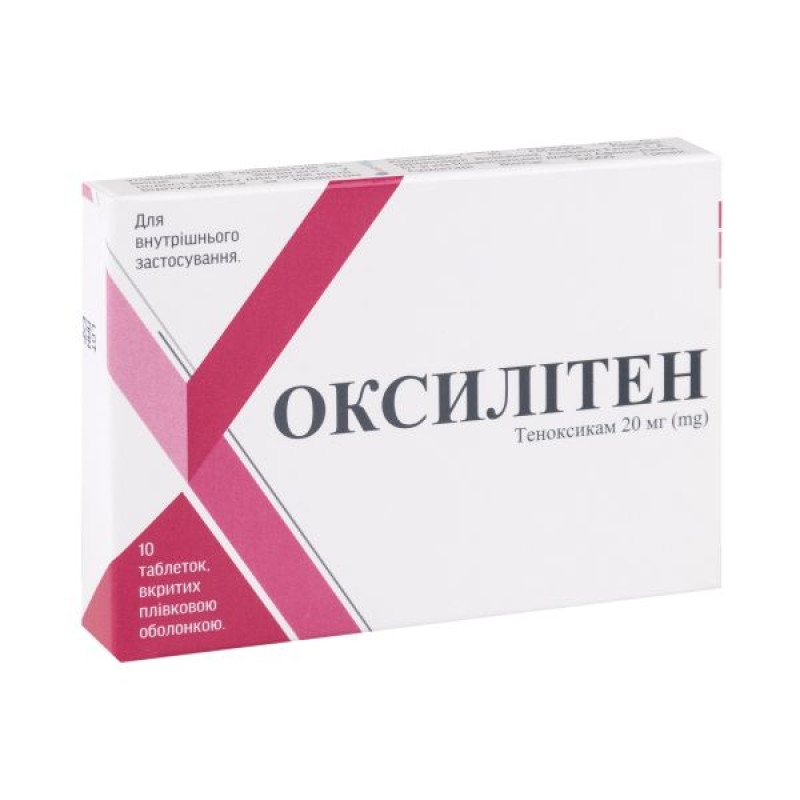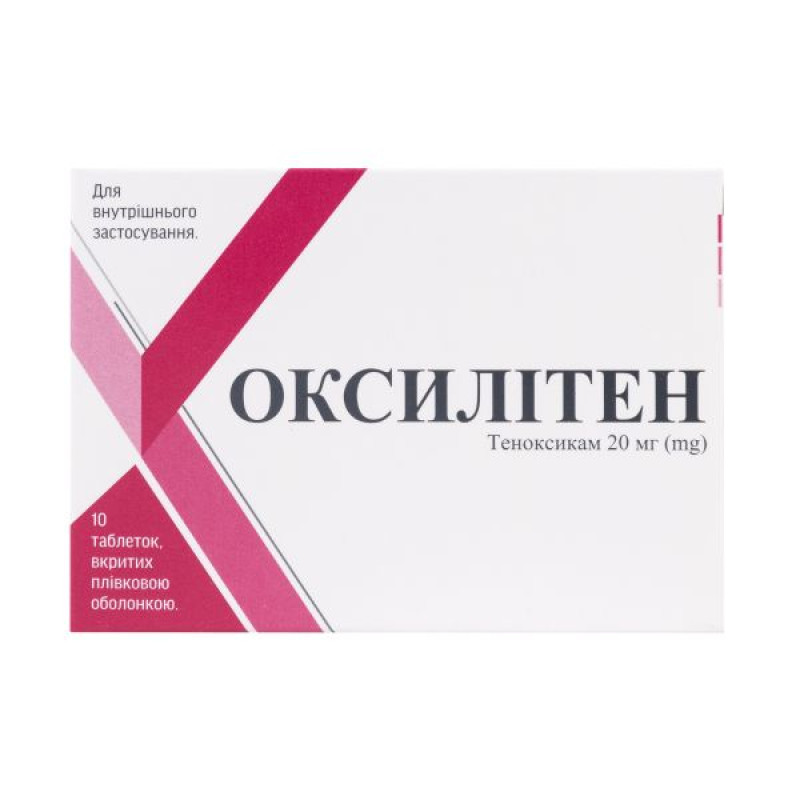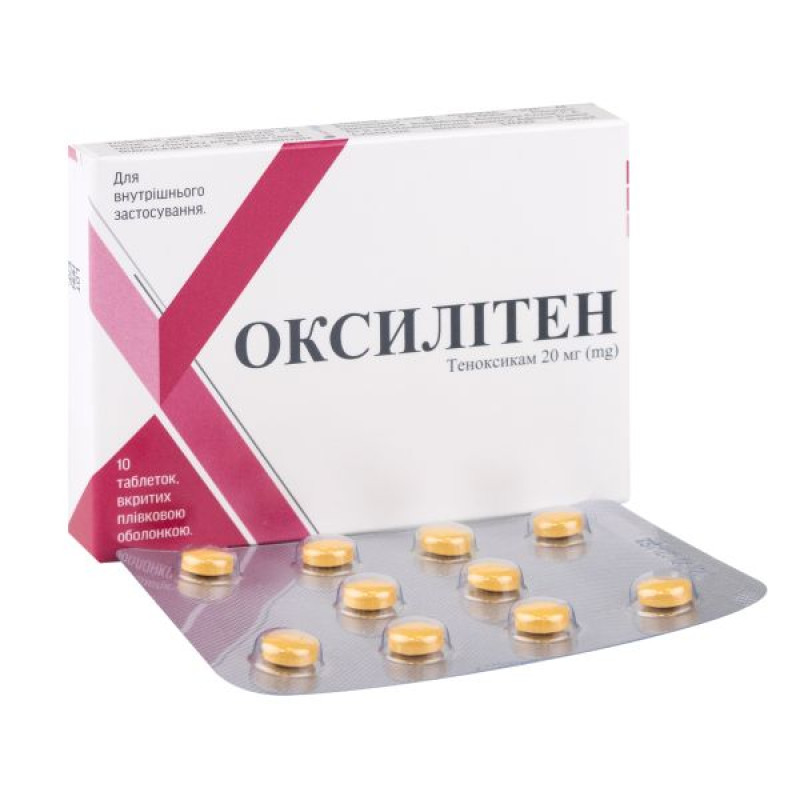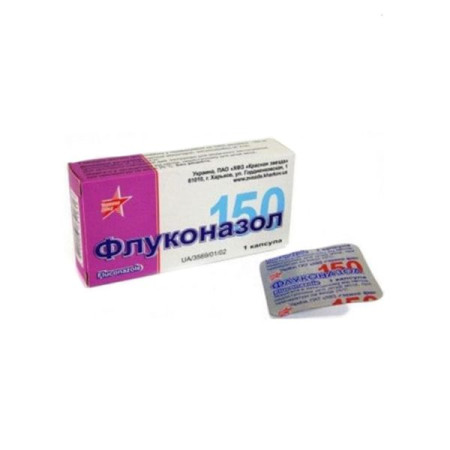Oxyliten film-coated tablets 20 mg blister No. 10

Instructions for Oxyliten film-coated tablets 20 mg blister No. 10
Composition
active ingredient: tenoxicam;
1 tablet contains tenoxicam 20 mg;
excipients: lactose monohydrate; corn starch; talc; magnesium stearate; coating: hypromellose, talc, titanium dioxide (E 171), iron oxide yellow (E 172).
Dosage form
Film-coated tablets.
Main physicochemical properties: brownish-yellow round biconvex tablets.
Pharmacotherapeutic group
Nonsteroidal anti-inflammatory drugs. Oxycodone. ATX code M01A C.
Pharmacological properties
Pharmacodynamics
Tenoxicam is a nonsteroidal anti-inflammatory drug of the oxicam class. It has analgesic and anti-inflammatory effects, the antipyretic effect is less pronounced. The mechanism of action is based on non-selective blocking of the activity of COX-1 and COX-2 isoenzymes, disrupting the metabolism of arachidonic acid, as a result of which the synthesis of prostaglandins at the site of inflammation, as well as in other tissues of the body, is reduced. In addition, tenoxicam reduces the accumulation of leukocytes at the site of inflammation. Tenoxicam reduces capillary permeability, stabilizes lysosomal membranes; inhibits the release of macroergic compounds (primarily ATP) in the processes of oxidative phosphorylation; inhibits the synthesis or inactivates inflammatory mediators (prostaglandins, histamine, bradykinins, lymphokines, complement factors, etc.). Blocks the interaction of bradykinin with tissue receptors, restores impaired microcirculation and reduces pain sensitivity at the site of inflammation. Affects the thalamic centers of pain sensitivity (local blockade of the synthesis of PgEl, PgE2 and PgF2 alpha).
The analgesic effect is due to a decrease in the concentration of biogenic amines, which have algogenic properties, and an increase in the pain threshold of the receptor apparatus. It relieves or reduces the intensity of pain syndrome of any etiology, reduces morning stiffness, increases the mobility of affected joints. With prolonged use, it exhibits a desensitizing effect. A feature of tenoxicam is its long-term action.
Pharmacokinetics
Quickly and completely absorbed from the digestive tract. Eating slows down the rate of absorption. Bioavailability is 100%. The maximum concentration of the drug in the blood is reached 2 hours after administration. The half-life is 60–75 hours. The drug is 99% bound to blood plasma proteins, penetrates well into the synovial fluid, 67% is excreted in the urine. It is hydroxylated in the liver, forming 5-hydroxytenoxicam. It easily passes through histohematological barriers. The main part is excreted in the form of inactive metabolites in the urine, the rest - in the bile.
Indication
Treatment of pain and inflammation in osteoarthritis and rheumatoid arthritis.
Short-term treatment of inflammatory-degenerative diseases of the musculoskeletal system, including dislocations and other soft tissue injuries.
Contraindication
Hypersensitivity to tenoxicam, to other components of the drug, to ibuprofen, acetylsalicylic acid or to other non-steroidal anti-inflammatory drugs (NSAIDs) (symptoms of bronchial asthma, rhinitis, angioedema or urticaria); severe cardiac, hepatic and renal failure; active peptic ulcer, gastrointestinal bleeding in the acute stage, ulcers or bleeding in history (two or more pronounced established episodes of ulceration or bleeding); gastrointestinal bleeding or perforation (in history) associated with previous use of NSAIDs.
Interaction with other medicinal products and other types of interactions
Therapeutic doses of tenoxicam have no pharmacokinetic interactions with antacids, cimetidine, oral anticoagulants, or hypoglycemic agents; however, it may enhance the effects of anticoagulants such as coumarin and warfarin.
Probenecid: enhances the elimination of tenoxicam.
Cardiac glycosides: No interaction with digoxin has been reported; NSAIDs may exacerbate heart failure, reduce glomerular filtration rate, and increase plasma levels of cardiac glycosides.
Diuretics: NSAIDs can retain potassium, sodium, and fluid and reduce the natriuretic effect of diuretics, increasing the risk of nephrotoxicity. Therefore, in patients with hypertension or heart failure, tenoxicam may worsen the course of these diseases.
Lithium: continuous monitoring is recommended. When taking lithium preparations, manifestations of lithium intoxication are possible as a result of reduced lithium elimination.
Methotrexate: possible manifestations of methotrexate intoxication as a result of reduced elimination.
Cyclosporine: increased risk of nephrotoxicity.
Mifepristone: NSAIDs should not be used for 8–12 days after taking mifepristone, as they can reduce the effect of mifepristone.
Other analgesics: simultaneous administration of two or more NSAIDs should be avoided due to the increased risk of gastrointestinal bleeding and ulcers.
Corticosteroids: increased risk of gastrointestinal bleeding.
Anticoagulants: May enhance the anticoagulant effect of warfarin and other anticoagulants. The effect of anticoagulants and oral hypoglycemic agents should be monitored particularly carefully during the initial stages of treatment with tenoxicam.
Quinolone antibiotics: with simultaneous use, the risk of developing seizures increases.
Antiplatelet agents and serotonin receptor blockers: increased risk of gastrointestinal bleeding.
Application features
When using Oxyliten, it is necessary to monitor the function of the digestive tract. If the first signs of ulcerogenesis or gastrointestinal bleeding are detected, the drug should be immediately canceled. Use with caution in patients with impaired renal function, conduct constant monitoring in case of worsening renal failure, use of diuretics and nephrotoxic drugs, increase in blood urea nitrogen, serum creatinine, body weight, in diabetic nephropathy, peripheral edema in elderly patients, congestive heart failure, hypovolemia.
In renal failure, patients with creatinine clearance more than 25 ml/min require medical supervision without dose adjustment. Caution should be exercised in patients with impaired liver function, low plasma albumin concentration, such as nephrotic syndrome, or high bilirubin concentration. If a significant increase in transaminases is observed during treatment with Oxylitene, which persists during therapy, the drug should be discontinued.
Oxyliten can retain potassium ions, lithium, and also liquid. Therefore, in persons with arterial hypertension or heart failure, tenoxicam can worsen the course of these diseases. Appropriate control is required for patients who have a history of moderate and/or severe heart failure with the appearance of edema during NSAID therapy. Tenoxicam reduces platelet aggregation and may increase blood clotting time. This should be borne in mind if patients have undergone major surgery (e.g., joints), and blood clotting time should be carefully monitored. Patients who are prescribed oral anticoagulants or hypoglycemic drugs should be under close supervision, and the drug should not be used if monitoring is not possible.
Oxyliten should not be used with other NSAIDs, including selective cyclooxygenase-2 inhibitors.
Respiratory system
Caution is required when treating patients who suffer from or have a history of bronchial asthma, as the drug may cause bronchospasm in such patients.
Cardiovascular, hepatic and renal disorders
The use of NSAIDs in rare cases can cause interstitial nephritis, papillary necrosis, glomerulonephritis and nephrotic syndrome. Such agents inhibit the synthesis of renal prostaglandins, which play a supporting role in maintaining renal perfusion in patients, and against this background, blood volume and renal blood flow decrease. The administration of NSAIDs can provoke renal failure, which resolves immediately after discontinuation of the drug. Patients are at greatest risk of such a reaction when they have pre-existing kidney disease (including diabetic patients with impaired renal function), nephrotic syndrome, dehydration, liver disease, congestive heart failure, and if they are receiving concomitant therapy with diuretics or potentially nephrotoxic drugs. Such patients should be carefully monitored for renal, hepatic and cardiac function, and the dose should be lower than in other patient groups. NSAIDs should be used with caution in patients with a history of heart failure or hypertension, as there are reports that edema that occurs with NSAIDs may be associated with tenoxicam. There have been reports of increases in serum transaminases or other liver function tests. In most cases, these were minor and transient changes. If the abnormalities are significant or persistent, Oxyliten should be discontinued and liver function tests should be monitored until they return to normal.
Cardiovascular disorders
Appropriate monitoring and advice are necessary for patients with hypertension and/or a history of mild to moderate heart failure, as fluid retention and oedema have been reported with the use of NSAIDs. Clinical studies have shown that the use of some NSAIDs (especially at high doses and in long-term treatment) may be associated with a small increased risk of arterial thrombosis (e.g. myocardial infarction or stroke). There is insufficient data to exclude such a risk with tenoxicam.
Tenoxicam should be used only after careful assessment in patients with uncontrolled hypertension, heart failure, established coronary artery disease, peripheral arterial disease and/or cerebrovascular disease. This assessment should be performed before initiating long-term treatment in patients with risk factors for cardiovascular disease (e.g. hypertension, hyperlipidemia, diabetes mellitus, smoking).
There have been reports of gastrointestinal bleeding, ulceration or perforation, which can be fatal, occurring with the use of NSAIDs.
The risk of gastrointestinal bleeding, ulceration or perforation is higher when high doses of NSAIDs are used in patients with a history of ulcer, especially if the bleeding or perforation is severe. These patients should start treatment with a lower dose. For such patients and patients who require concomitant low-dose acetylsalicylic acid or other medicinal products, combination therapy with protective agents (e.g. misoprostol or proton pump inhibitors) may be considered to reduce the risk to the gastrointestinal tract. Patients with a history of gastrointestinal disorders, especially the elderly, should inform their doctor of any symptoms from the gastrointestinal tract (in particular gastrointestinal bleeding), especially at the beginning of treatment.
Caution should be exercised when prescribing the drug to patients receiving medications that increase the risk of ulceration or bleeding, such as oral corticosteroids, anticoagulants (e.g. warfarin), selective serotonin reuptake inhibitors or platelet agents (e.g. acetylsalicylic acid).
If a patient develops gastrointestinal bleeding or ulceration during treatment with Oxyliten, therapy with the drug should be discontinued immediately.
Patients with a history of gastrointestinal diseases (ulcerative colitis, Crohn's disease) should be prescribed the drug with caution, as tenoxicam may exacerbate their manifestations.
Patients with systemic lupus erythematosus, a mixed connective tissue disease, are at increased risk of aseptic meningitis.
Dermatology
There have been isolated reports of severe skin reactions, some of which were fatal, including exfoliative dermatitis, Stevens-Johnson syndrome, and toxic epidermal necrolysis, during the use of NSAIDs.
In the early stages of therapy, there is a high risk of such reactions: manifestations are observed in the first months of treatment.
Treatment with Oxylitene should be discontinued at the first appearance of skin rashes, mucosal lesions, or other hypersensitivity reactions.
Decreased fertility
The use of Oxyliten may impair female fertility, so it is not recommended for women who wish to become pregnant.
Tenoxicam should not be prescribed to women who are unable to become pregnant or who have been diagnosed with infertility.
Ophthalmic adverse reactions
Undesirable effects on the visual organs have been reported with NSAIDs, therefore patients who develop visual disturbances during treatment with Oxyliten should have their visual function assessed.
Life-threatening skin reactions (Stevens-Johnson syndrome and toxic epidermal necrolysis) have been reported with the use of tenoxicam.
Patients with signs of skin reactions should be monitored.
During the first weeks of treatment, there is a high risk of developing Stevens-Johnson syndrome and toxic epidermal necrolysis.
If signs of Stevens-Johnson syndrome and toxic epidermal necrolysis occur (e.g. progressive skin rash, more often with blisters, or maculopapular lesions), treatment with tenoxicam should be discontinued.
The best results in the treatment of Stevens-Johnson syndrome and toxic epidermal necrolysis are achieved with early diagnosis and immediate discontinuation of any suspected drug.
Tenoxicam should no longer be prescribed to patients who develop Stevens-Johnson syndrome and toxic epidermal necrolysis when using it.
The drug contains lactose, therefore patients with rare hereditary forms of galactose intolerance, lactase deficiency or glucose-galactose malabsorption syndrome should not use the drug.
Ability to influence reaction speed when driving vehicles or other mechanisms
No studies have been conducted on the effect of the drug on the ability to drive or operate other mechanisms. However, given the side effects of the drug on the nervous system and visual organs, it is not recommended to drive or operate complex mechanisms.
Use during pregnancy or breastfeeding
Do not use the drug.
Breastfeeding should be discontinued during treatment with the drug, as the effects on breastfed infants are unknown.
Method of administration and doses
Tablets should be taken orally with liquid, preferably with or after food.
Adults: the recommended dose is 1 tablet (20 mg) once a day at the same time every day.
You should not exceed the recommended doses, as this does not provide a significant therapeutic effect, but at the same time increases the risk of side effects.
In acute diseases of the musculoskeletal system, the treatment period usually exceeds 7 days, but in severe cases, the treatment can be extended to a maximum of 14 days.
Oxyliten, like other NSAIDs, should be used with caution due to lower tolerance to side effects than in younger patients. Elderly patients are more likely to receive concomitant medications or have impaired renal, hepatic, or cardiovascular function. If NSAIDs are necessary, low doses should be prescribed for a long time. Patients should be monitored because occult gastrointestinal bleeding may occur within 4 weeks of starting therapy.
Patients with renal and hepatic impairment
| Creatinine clearance | Dosage |
| More than 25 ml/min | Under the supervision of a physician without dosage adjustment |
| Below 25 ml/min | Insufficient data to make a dosage recommendation |
Caution should be exercised in cases of low albumin concentrations (e.g. nephrotic syndrome) or high plasma bilirubin concentrations, as tenoxicam is highly bound to plasma proteins.
There are insufficient data to recommend a dosage of Oxyliten in patients with hepatic impairment.
Children
There are no data on the safety of tenoxicam in children, so it should not be prescribed to this category of patients.
Overdose
There have been no reports of severe cases of tenoxicam overdose.
Symptoms: headache, dizziness, nausea, vomiting, diarrhea, pain or discomfort in the epigastrium, diarrhea, gastrointestinal bleeding, disorientation, agitation, coma, drowsiness, vertigo, tinnitus, weakness, fainting, sometimes convulsions. Active renal or hepatic failure is possible in severe poisoning.
Treatment. If necessary, symptomatic therapy should be carried out. In the first hour of poisoning, the stomach should be washed and activated charcoal should be taken. Good urine output should be ensured. It is necessary to monitor kidney and liver function. Patients should be under medical supervision for 4 hours after overdose. In case of frequent and prolonged convulsions, diazepam is administered intravenously. There is no specific antidote.
Adverse reactions
The most common side effects are erosive-ulcerative lesions of the digestive tract, including ulcerogenic effects.
Gastrointestinal: nausea, vomiting, diarrhea, constipation, heartburn, dyspepsia, abdominal pain, melena, epigastric distress, hematemesis, flatulence, ulcerative stomatitis, gastrointestinal hemorrhage, gastritis, peptic ulcers or gastrointestinal bleeding.
On the part of the hepatobiliary system: impaired liver function, hepatitis, jaundice, possible increase in blood transaminase levels.
From the blood and lymphatic system: thrombocytopenia; thrombocytopenic purpura; neutropenia; agranulocytosis; aplastic anemia and hemolytic anemia; decrease in hemoglobin levels not associated with bleeding; leukopenia; eosinophilia.
Metabolic: hyperglycemia, weight gain or loss.
From the nervous system: agitation, optic neuritis, paresthesia, depression, nervousness, hallucinations (confusion), drowsiness or insomnia, sleep disturbances, tinnitus, malaise, weakness, increased fatigue, headache, dizziness, tremor.
On the part of the organs of vision: eye irritation and swelling, blurred vision.
There were no cases of visual impairment detected by slit lamp or ophthalmoscope examination.
Cardiovascular system: edema, dyspnea, tachycardia, palpitations. Possible development of heart failure, arterial hypertension associated with NSAID treatment. Elderly people with cardiac functional disorders should be used with caution, since increased edema can lead to congestive heart failure.
NSAIDs (at high doses and long-term use) may increase the risk of arterial thrombosis (myocardial infarction, stroke).
Urinary system: nephrotoxicity, including interstitial nephritis, nephrotic syndrome, and renal failure.
Hypersensitivity reactions: nonspecific allergic reactions, anaphylactic reactions, respiratory tract reactivity, including bronchial asthma, bronchospasm or dyspnea; skin disorders - rash, itching, urticaria, angioedema, bullous dermatitis (including toxic epidermal necrolysis, erythema multiforme and exfoliative dermatitis), possible alopecia, photosensitivity, Lyell's syndrome, Stevens-Johnson syndrome.
Laboratory indicators: increased blood transaminase levels, hyperglycemia, reversible increase in blood urea nitrogen and creatinine in blood plasma.
If any of the adverse reactions occur, treatment should be discontinued. Adverse reactions can be minimized by using the lowest effective dose for the shortest duration.
Expiration date
3 years.
Storage conditions
Store in the original packaging at a temperature not exceeding 25 °C.
Keep out of reach of children.
Packaging
10 tablets in a blister, 1 blister in a cardboard box.
Vacation category
According to the recipe.
Producer
Anfarm Ellas S.A.
61st km of the Athens-Lamia National Road, Shimatari Viotias, 32009, Greece.
There are no reviews for this product.
There are no reviews for this product, be the first to leave your review.
No questions about this product, be the first and ask your question.













